Napoli had a poor form in recent months – despite winning the last game with four goals in midweek, Carlo Ancelotti was sacked because of his poor relationship with De Aurelio De Laurentiis. AC Milan legend and former manager Gennaro Gattuso took charge of the club and it was the first game of him as a Napoli manager.
Parma did very fine in this campaign, before the game they had 21 points in the Serie A – same with Napoli. In the past six games, they only lost one of them, while securing a win on Roma. They looked for all three points in the San Paolo.
In this tactical analysis, we will show you the tactics of Napoli and Parma, it is an analysis explained how Parma got their win.
Lineups
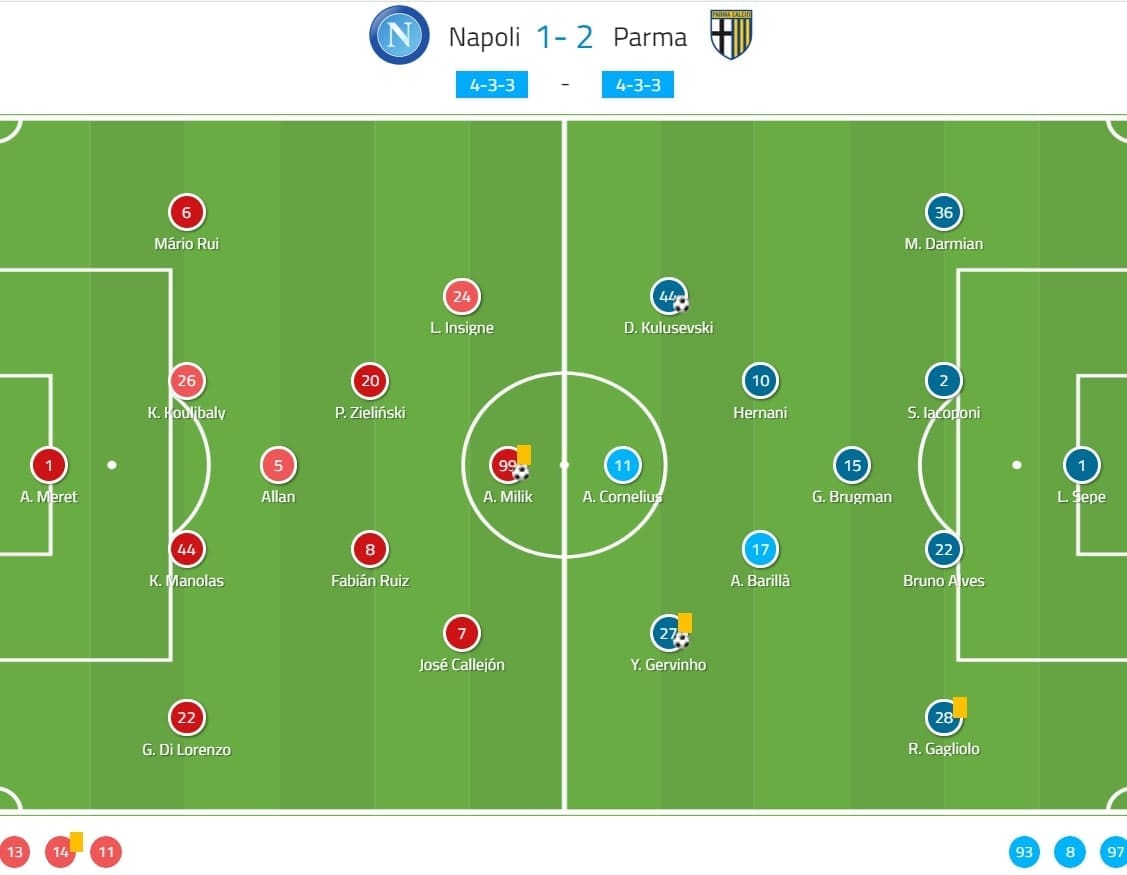
The first lineup for Gattuso’s Napoli was in a 4-3-3 formation, with Alex Meret in goal; Giovanni Di Lorenzo, Mário Rui, Konstantinos Manolas, and Kalidou Koulibaly formed the back four, but as Koulibaly was later injured early in this game, he was then replaced by Sebastiano Luperto; Allan, Piotr Zieliński and Fábian Ruiz were the midfield trio; and José Callejón, Arkadiusz Milik, and Lorenzo Insigne were the front three.
Roberto D’Aversa also played his team in a 4-3-3 formation. Luigi Sepe was in goal, with Matteo Darmian, Riccardo Gagliolo, Simone Iacoponi, and Bruno Alves as the defenders. Gastón Brugman, Hernani, Antonio Barrilà started in the midfield. Dejan Kulusevski, Andreas Cornelius and Gervinho started ahead of the midfielders.
The defence of Parma
Parma only pressed high on occasions, they generally formed a 4-3-3 midblock in their own half. They tried to stay compact horizontally at the centre, allowing both flanks to be open. In most cases, Cornelius would be marking Allan, if the ball was on the feet of either centre-back. This avoided the Brazilian pivot receiving the ball from the centre-backs.
It was an intriguing pattern when looking at the defensive work on Cornelius. When the ball moved to the flank, instead of marking Allan tightly, the Danish pressed the return ball to the centre-backs. This gave room for Napoli to find Allan through the full-backs, but it took a while for Gattuso’s man to discover this path. As the below scene shows, Rui received the ball with a closed body orientation, which constrained his next move. The left-back could not turn smoothly to find the forward option Insigne in an instant, while he was also reluctant to pass to Allan with his weaker foot. At last, he dribbled the ball out of the pitch.
Gervinho’s position was a notable one as he was the main man in the attack, yet he did not have to stay behind the ball all the time. In terms of the defensive shape, Parma had some loopholes for Napoli to capitalise on (as we will explain afterwards).
Even in their own third, Parma seldom engaged intensively, they preferred retreating to the box and defending crosses. The statistics showed Parma managed to defend 70% of Napoli crosses.
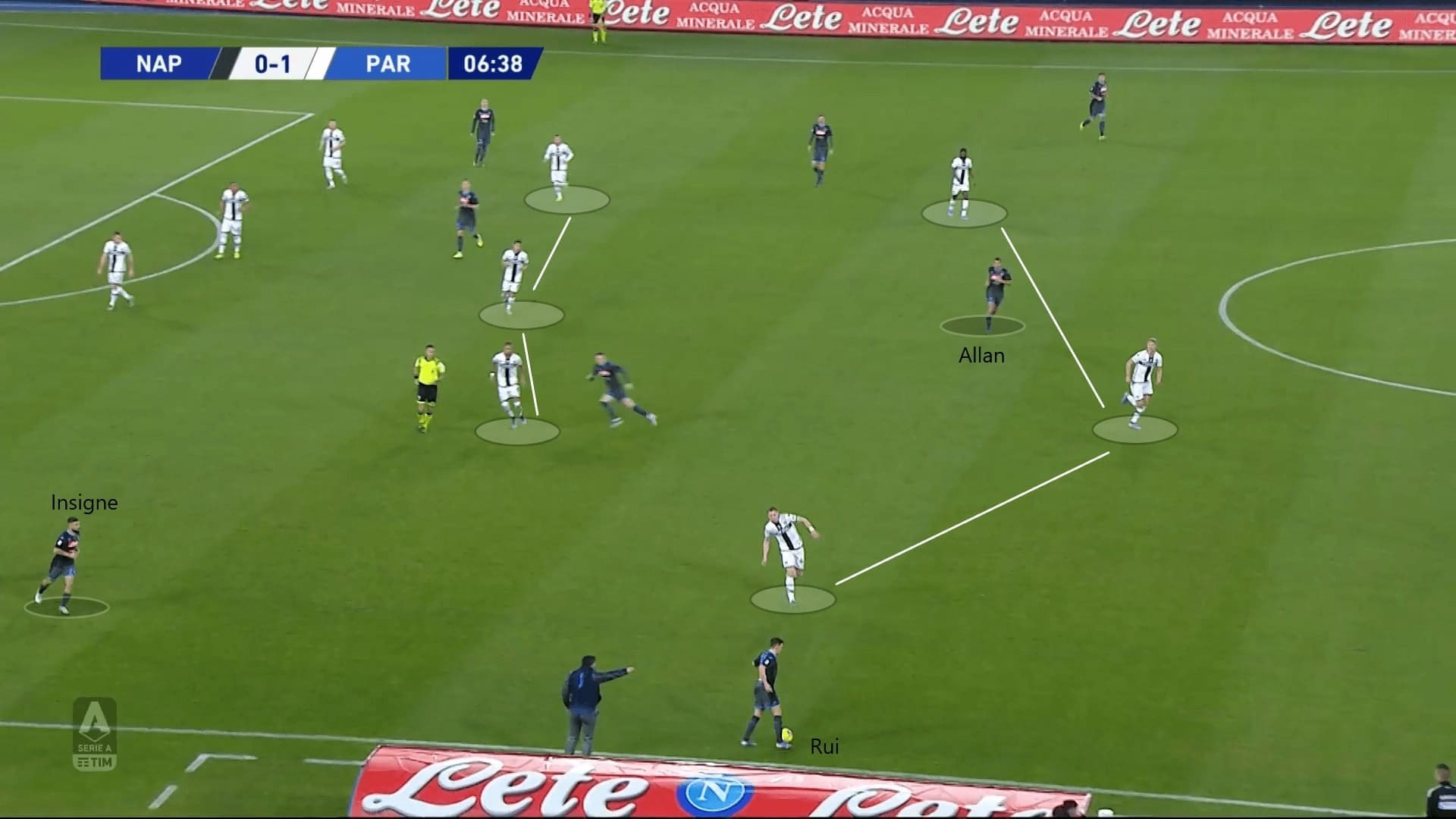
The build-up of Napoli
With a 4-3-3 formation, Napoli played the build-up without too many problems, even though their ball-playing centre back Koulibaly was injured early. Despite Parma maintaining a midblock, Napoli could still build up through the flanks or even the centre of the pitch. Their players moved enough to create spaces for each other.
This scene below showed how Napoli built up through the flanks. In this match, both full-backs Di Lorenzo and Rui stayed wide and higher to provide width. Meanwhile, their wingers inverted to occupy the half-spaces, given Cornelius seldom provided immediate pressure on the ball and he did not mark Allan tightly. On this occasion, Allan received the ball without pressure when he dropped deeper.
When Allan looked for a forward pass, Insigne made an inside run. This allowed Allan to pass the ball through the gap between Hernani and Kulusevski. Also, the move further drew Parma defenders narrow as Darmian tracked him while the midfielders were focusing on the ball.
The pass of Allan eliminated the whole midfield line of Parma, and the attack progressed as Insigne played a first-time pass to Rui who was high and wide on the pitch. It ended with a cross from the Portugese left-back.
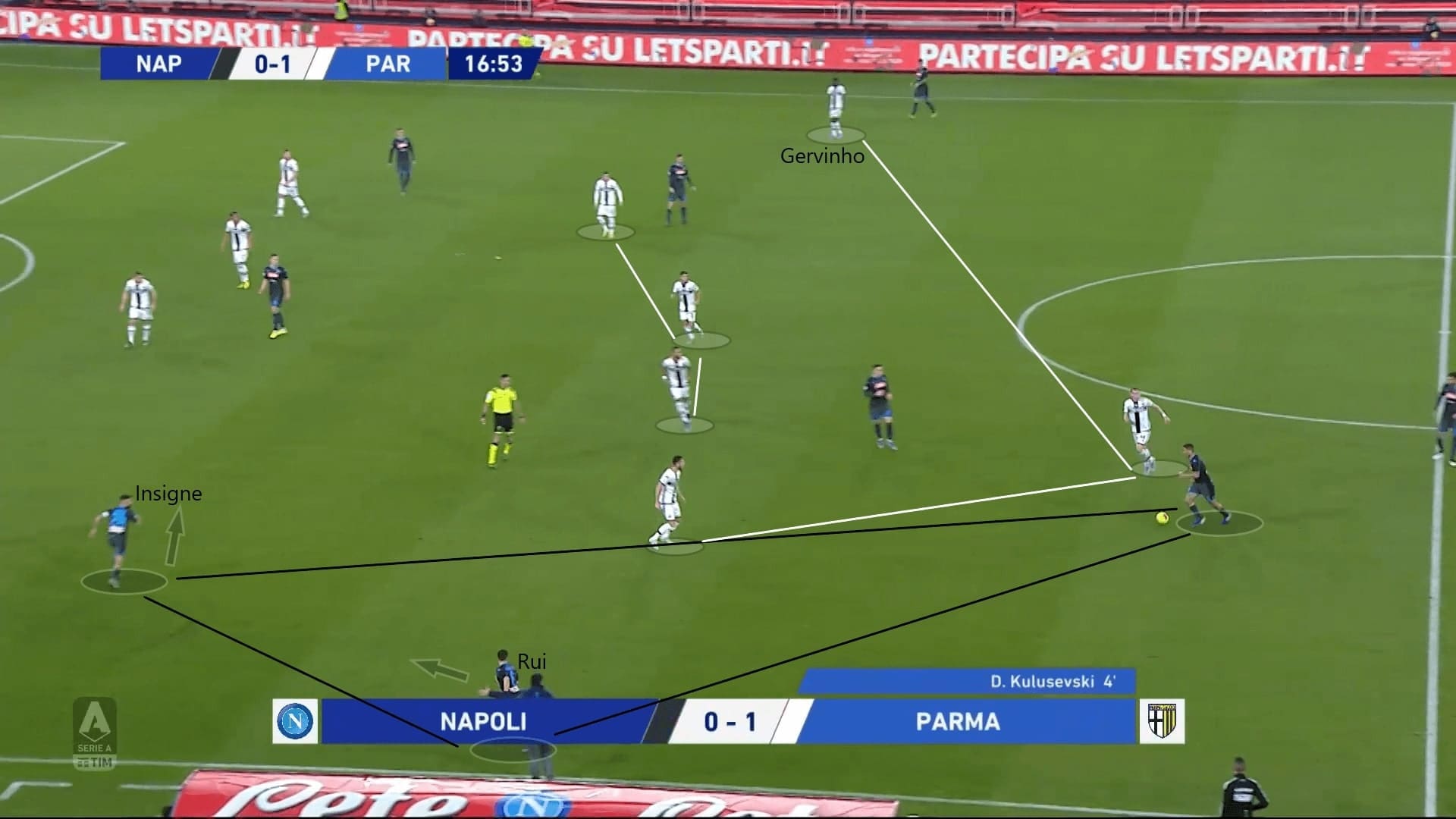
The midblock of Parma also failed to prevent Napoli from building up through the centre. The dropping movements of Napoli players were common and on this occasion, the midfield partners of Allan dropped to present themselves as passing options. Since the Parma players did not mark the opposition tightly, both Ruiz and Zieliński received the ball without much pressure.
With the dropping movements of midfielders, Napoli tried some third-man plays with Allan as the third man, as in the example below. Koulibaly found Ruiz, who got plenty of spaces to receive the ball as Barrilà did not mark him tightly. Meanwhile, Allan moved forward as the third man to receive the ball from the Spaniard, and as Allan could then spread the ball to Di Lorenzo, the play progressed.
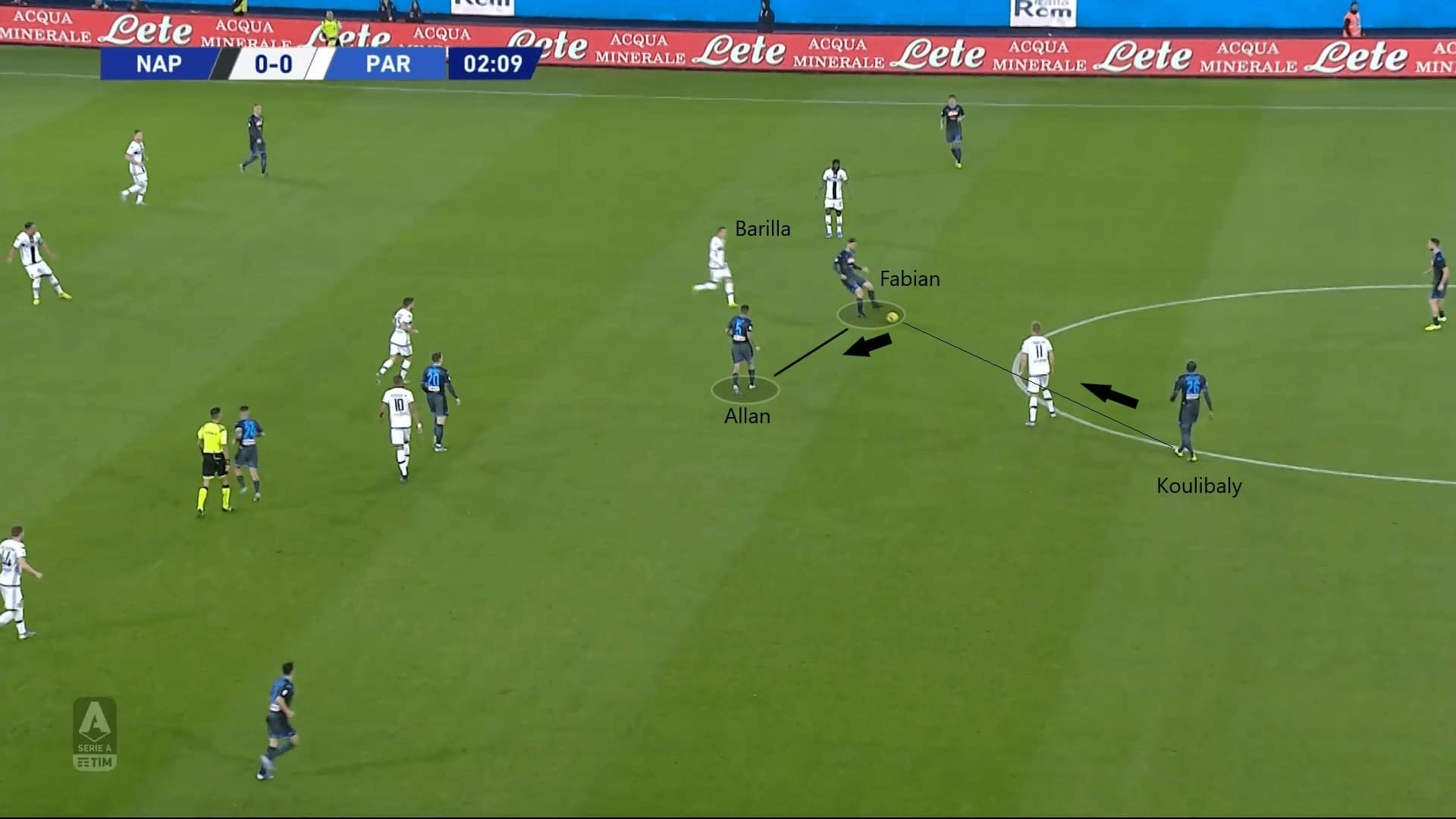
Another notable point was the defensive decisions of Cornelius. The Danish international seldom closed off Allan, therefore the Brazilian could face the goal and make forward passes and switch play comfortably. Below is the passing map of Allan, among his 44 successful passes, 20 – almost half of them – were forward passes as shown in the graph. Since he was not pressed when he got the ball, he made those passes easily in front of the central circle.
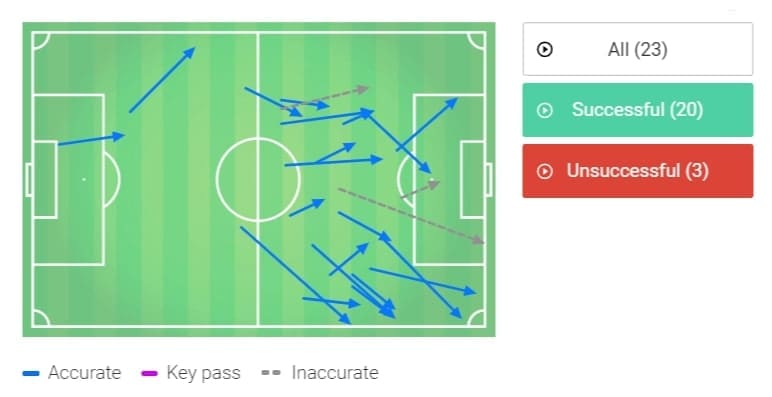
Napoli in the attacking third
In the attacking third, we can roughly split the actions of Napoli into two segments, given to the position of the ball, flanks or centre. Dropping moves of players were still an important element in this phase when Napoli tried to penetrate through the centre.
Below is the touch map of Milik, as the Polish international frequently dropped to the highlighted area as an option to get the ball. He made eight of the successful touches in that area, where there were huge spaces between Parma defenders and midfielders. When Milik dropped, both wingers Insigne and Callejón made diagonal forward runs to exploit the central area.
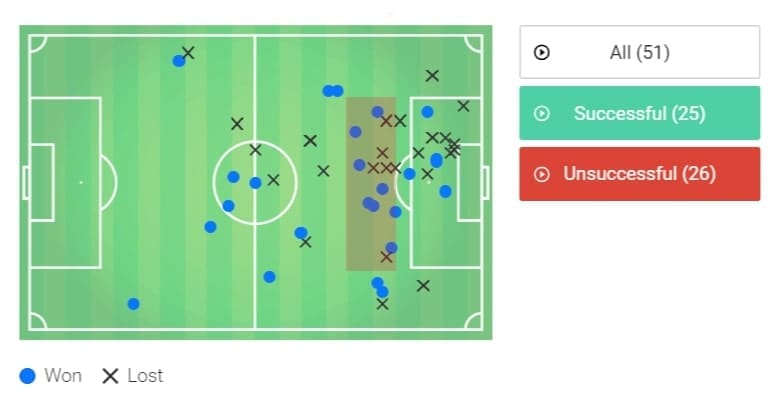
Napoli managed to create huge chances in this game, they obtained an xG of 2.93. The dropping movements of Milik successfully pulled the Parma centre-backs out of defence. In this occasion, both Alves and Iacoponi were caught. Both of them focused on Milik when the Polish international turned and looked for a pass, and they left huge spaces at the centre of the defence. Stepping out was not a problem, but the prerequisite was to win the ball or to force a return pass, and Iacoponi and Alves failed to do that. Insigne was ready to exploit those spaces, as this demonstrated example below shows a chance wasted by the Italian, with an xG of 0.45.
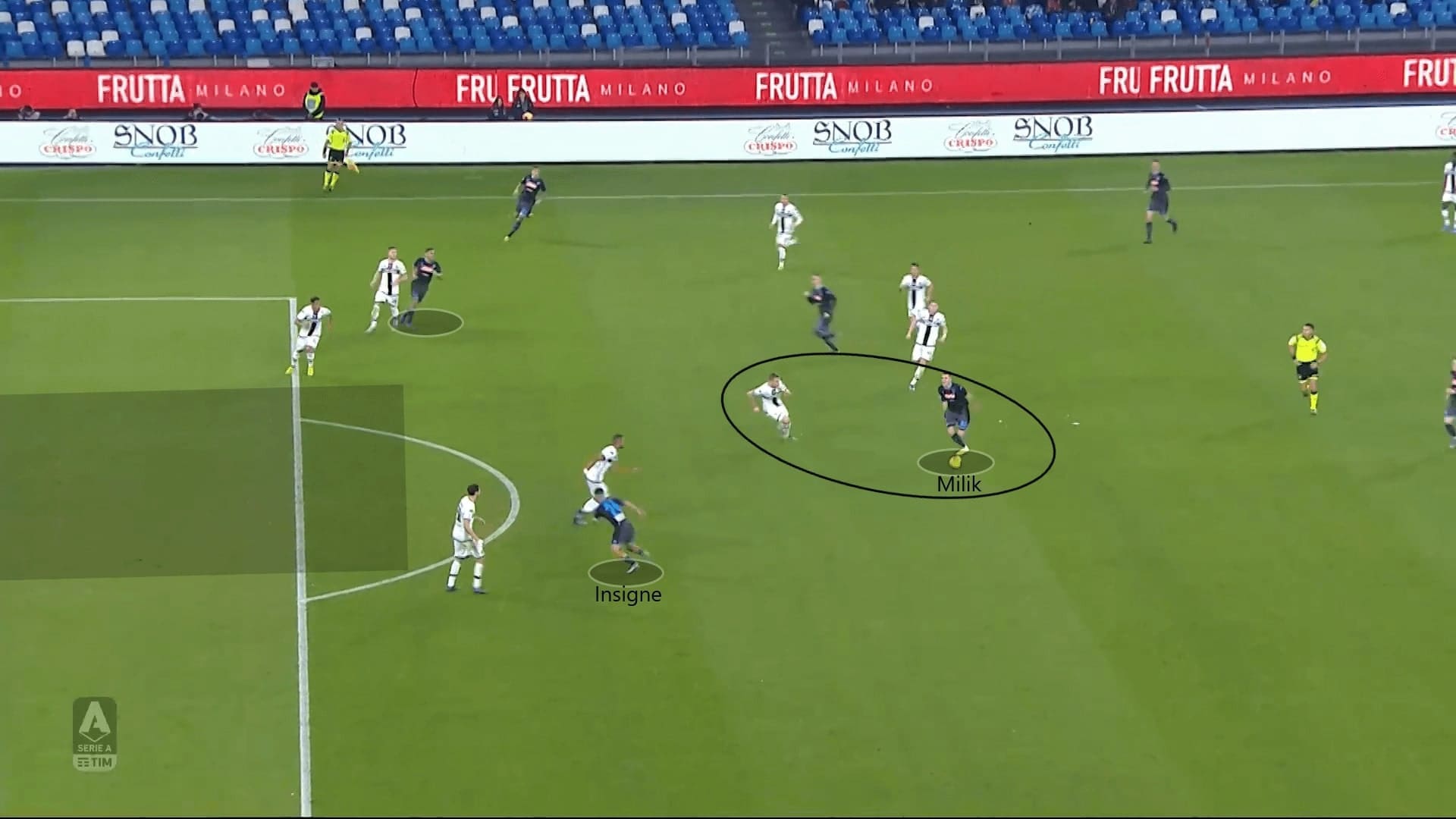
When the ball was on the flanks, Napoli heavily relied on the full-backs to provide crosses. For the 33 crosses made by Napoli players, 61% of them were made by the full-backs (Rui: 13; Di Lorenzo: seven). In order to open the flanks as corridors for the full-backs to move into, the Napoli wingers stayed narrow to the centre as they also looked to receive crosses. Meanwhile, Zieliński or Ruiz would be lurking at the edge of the area, in hopes of recovering the second balls.
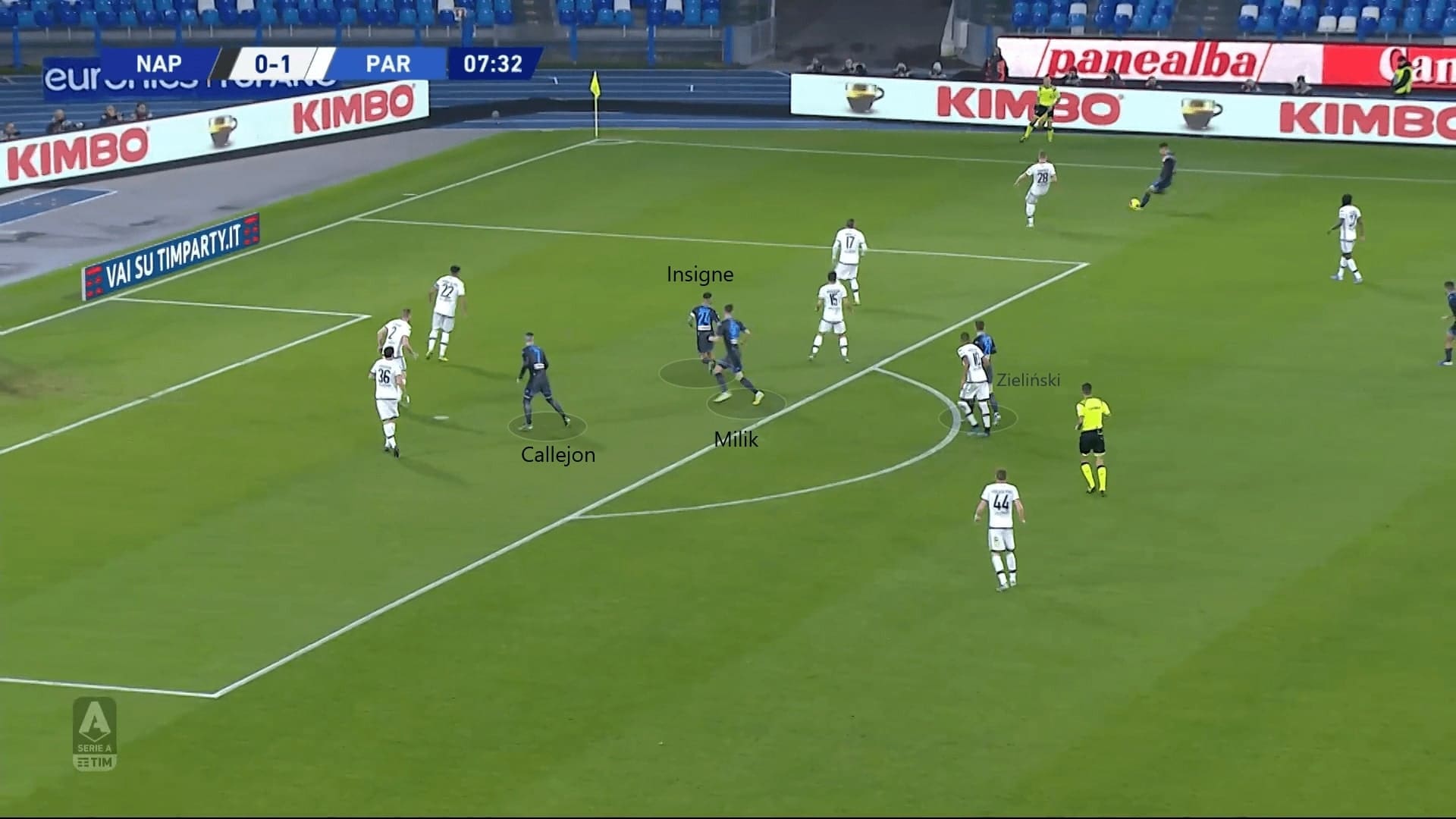
Parma’s attack
In contrast, the attack of Parma was rather simple with Gervinho as the focal point of the attack. The xG of Parma in the game was 0.97, and the former Arsenal man contributed 0.86 of them. Without much time on the ball (pure possession time of Parma was only 16 minutes), Parma resolutely attacked the flanks.
As the main man of the attack, this was the reason for Gervinho’s defensive positioning. He did not have to stay behind the ball all the time as Parma looked for quick transitions led by Gervinho. Since Di Lorenzo moved to an advanced position, the centre-backs were exposed. Among the ten dribbles made by Gervinho, on four occasions the Ivorian faced Luperto.
Furthermore, the wicked movements of Gervinho put Napoli defenders in a dilemma. If Gervinho moved inside, he would exploit the half-spaces between the right-back and right centre-back; if the Napoli defenders stayed compact horizontally, then the Parma no.27 got large spaces at the flanks to carry the ball. As the below scene reflected, Parma did not play out at the back while the Napoli players had committed numbers forward to deny the build-up. Iacoponi quickly played the ball to the flank, intending to find Gervinho, though Di Lorenzo intercepted.
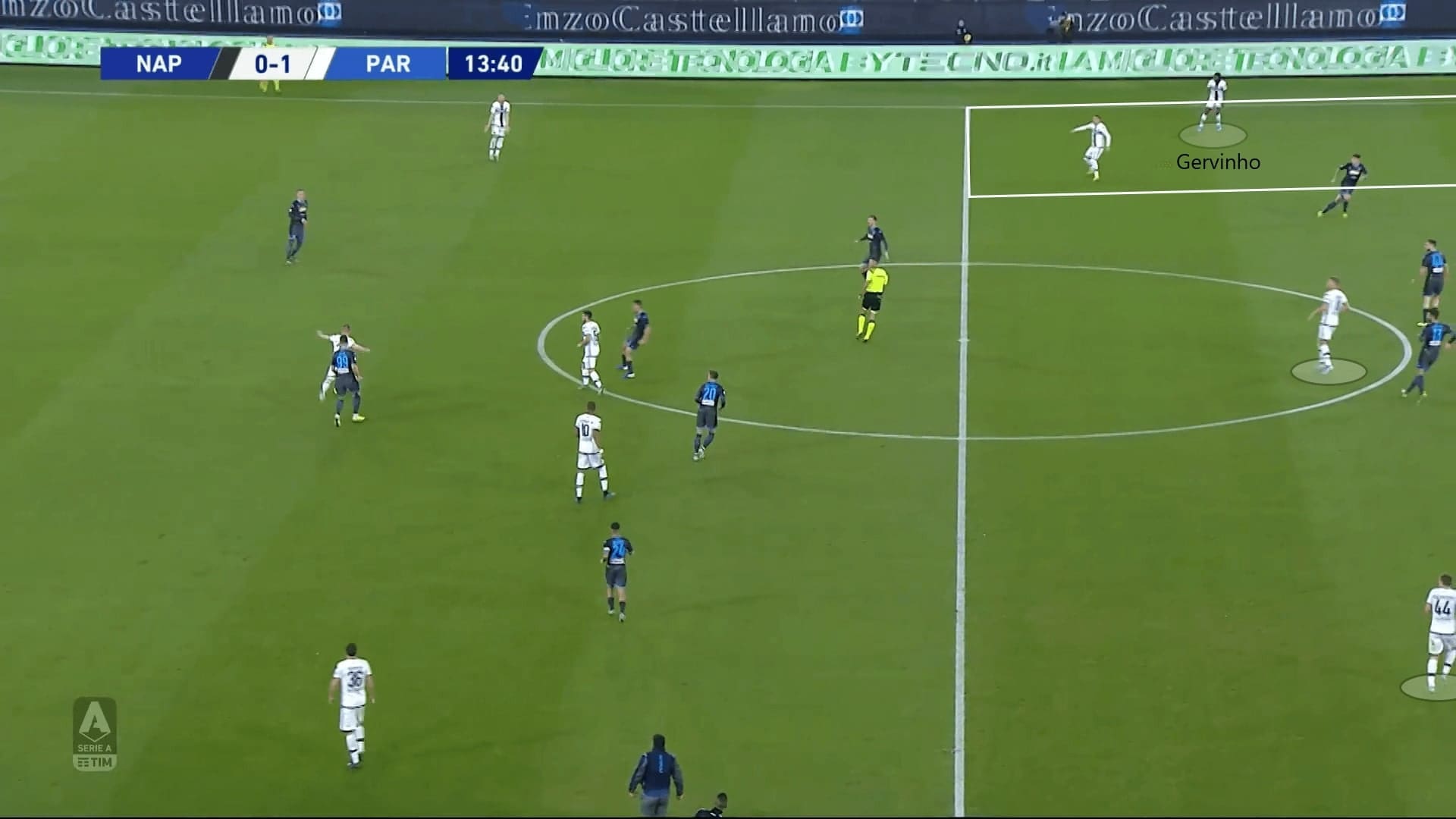
Gattuso tried to boost the attack
Napoli wanted a win at home, so Gattuso adjusted his tactics to make Napoli a more attacking team. He abandoned the formation in the first half, Allan was not the single-pivot anymore and he pushed forward to join the attack more often. Also, Ruiz and Zieliński were the midfielders who helped the team to progress the ball.
As the game went on, Gattuso needed a more offensive player in the team hence the introduction of Dries Mertens who came on to replace Allan. At this stage of the game, Napoli attacked in a 4-2-4 while defending in a 4-4-2. Their full-backs also kept pushing forward, providing overlapping runs.
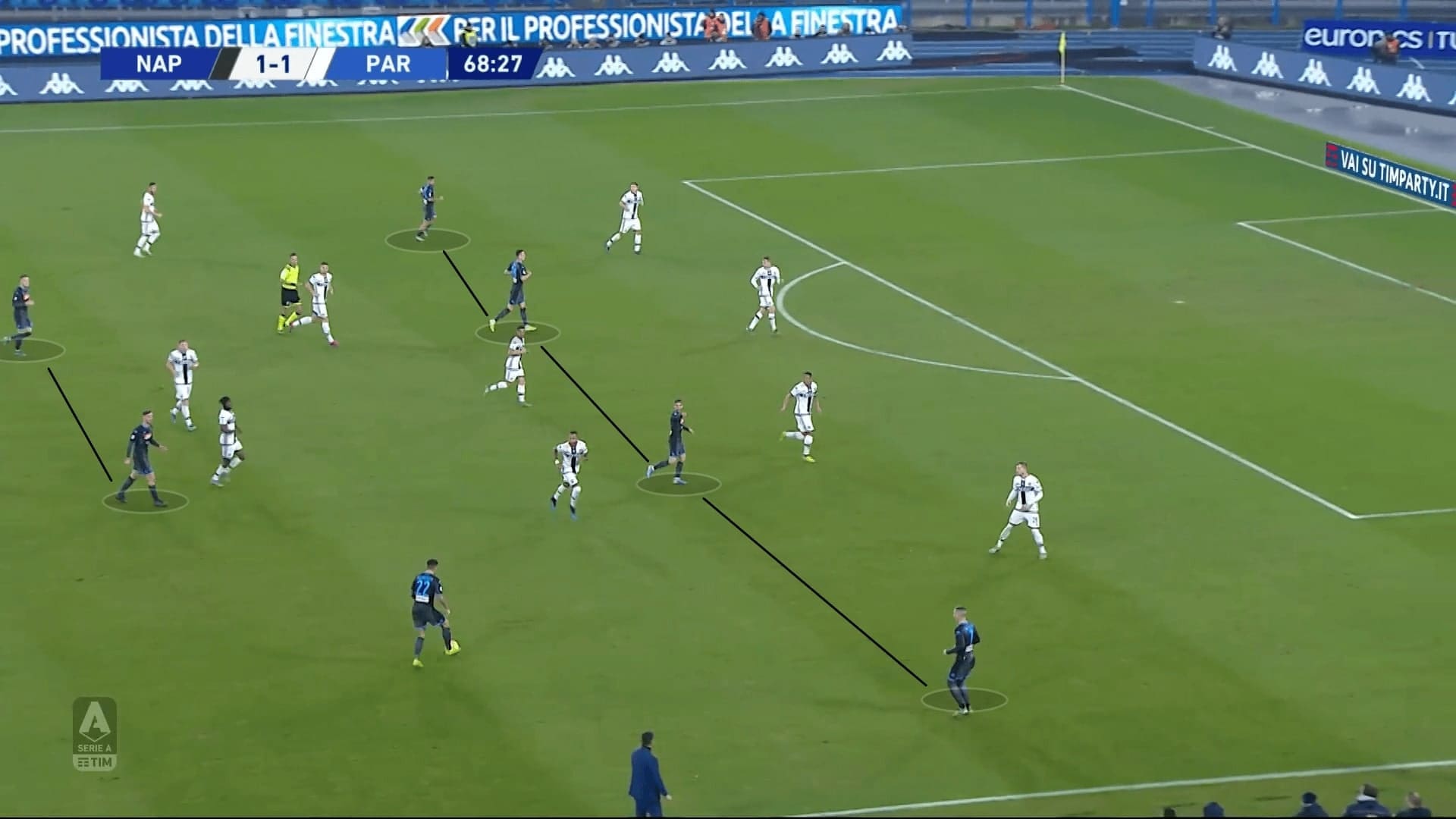
The changes of Gattuso gave his team more flexibility in the attack. Since he wanted to occupy a larger proportion of the attacking third, when Milik dropped, the wingers inverted into the centre, and the wide areas were uncontrolled if the full-backs did not occupy those spaces. With Mertens, their players could further stretch the defence of Parma as the away team were defending deeper in the second half.
This change made an immediate impact and led to Milik’s equaliser, as reflected in the below image. With Mertens on the pitch, Callejón could stay wider and combine with the right-back Di Lorenzo. Meanwhile, Milik and Mertens enjoyed the freedom to roam their positions – when one was out of the box to support the attack, the other one would attack the space at the centre of the defence. When Mertens was out of the box, Milik, who at first dropped deeper, found the gap between Parma defenders. Since Insigne stayed wider and drew the attention of Darmian, Milik could head the ball without pressure in the box.
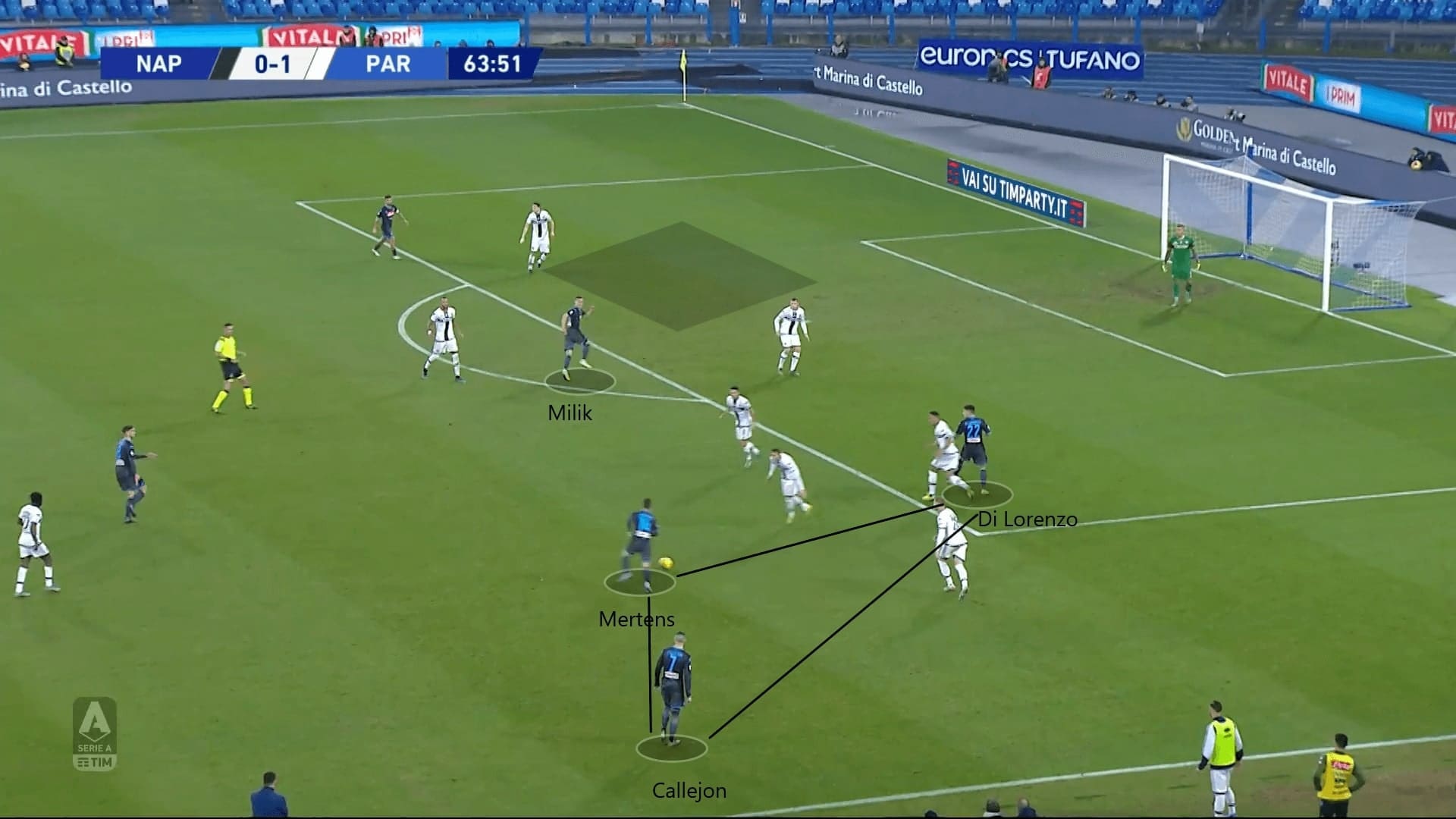
Conclusion
Despite losing this game, Napoli had dominated. However, they failed to convert their chances. We saw some elements that Gattuso may add to his team – for example, the use of third-man plays and the attacking full-backs. Napoli have to improve in front of goal in the future, and they also need to find ways to deal with quick transitions of opponents better when they commit numbers forward.
The key man of Parma was Gervinho was very sharp in this game and proved to be a nightmare for the Napoli defenders. Although the Ivorian is 32 years old already, he still possesses the pace to beat defenders. After the game, Parma climbed over Napoli, ranked seventh in the table.

If you love tactical analysis, then you’ll love the digital magazines from totalfootballanalysis.com – a guaranteed 100+ pages of pure tactical analysis covering topics from the Premier League, Serie A, La Liga, Bundesliga and many, many more. Buy your copy of the December issue for just ₤4.99 here





Comments